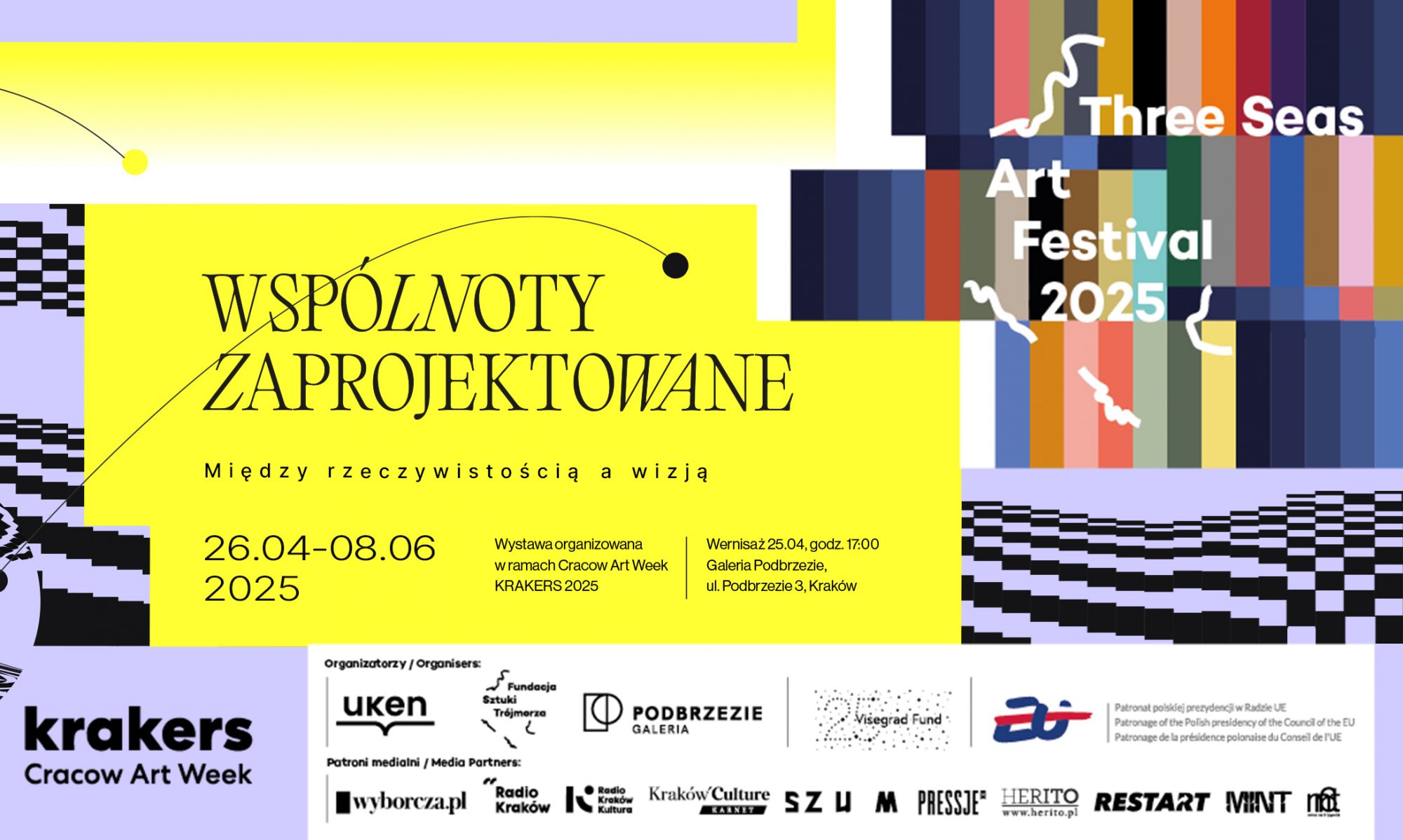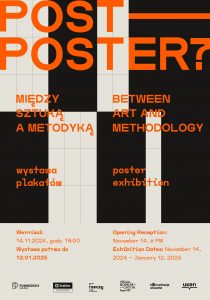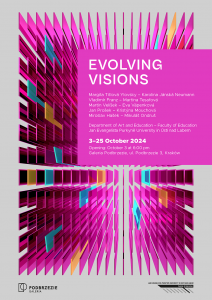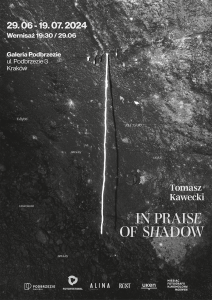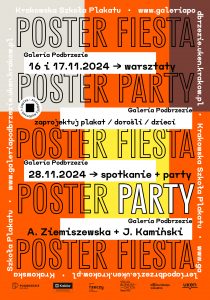
Krakowska Szkoła Plakatu to program wydarzeń towarzyszących wystawie Post-Poster? − między sztuką a metodyką.
Harmonogram wydarzeń:
POSTER–FIESTA – CAŁY WEEKEND Z PLAKATAMI! 16–17.11.2024
16.11.2024, SOBOTA, WARSZTATY, prowadząca Justyna Jędrysek
Godzina 10:00–11:00 Warsztaty dla dzieci: zaprojektuj z nami plakat!
Godzina 11:30–12:30 Warsztaty nie dla dzieci: plakat tradycyjny
17.11.24, NIEDZIELA, WARSZTATY, prowadząca Anna Zabdyrska
Godzina 10:00–11:00 Warsztaty dla dzieci: zaprojektuj z nami plakat!
Godzina 11:30–12:30 Warsztaty nie dla dzieci: plakat typograficzny
28.11.2024, czwartek, godzina 18:00–20.00, Galeria Podbrzezie –
SPOTKANIE–PROJEKTOWANIE: EDYCJA PLAKATY!
Agnieszka Ziemiszewska oraz Jakub Kamiński
+ 20:30–23.30 – POSTER PARTY – przebierz się za ulubiony plakat!
Nasze wydarzenia kierujemy do wszystkich chętnych do zapoznania się z tym co to jest plakat. Nie ma znaczenia czy ktoś zajmuje się projektowanie czy nie – w programie będą wydarzenia i dla tych którzy to medium dobrze znają i dla tych którzy nic o nim nie wiedzą. Będzie można oglądać, tworzyć, dyskutować, słuchać.
CO I DLA KOGO:
WARSZTATY DLA DZIECI 9–12 LAT:
Warsztaty skierowane do dzieci chętnych zmierzyć się z nowym dla nich medium – plakatem. Co może, a co musi znaleźć się na plakacie? Po co tworzy się plakaty? Jaki powinien być, aby przykuł uwagę odbiorcy? Podczas warsztatów dzieci stworzą własne plakaty na jeden z wybranych tematów!
Organizator zapewnia materiały warsztatowe. Proszę zadbać o strój dogodny do warsztatów kreatywnych. Zapraszamy rodziców do technicznego wsparcia młodych projektantów.
Prowadzące: Justyna Jędrysek (sobota) i Anna Zabdyrska (niedziela)
UWAGA: Zapisy! Na warsztaty obowiązują zapisy pod adresem: galeriapodbrzezie@up.krakow.pl
WARSZTATY PLAKAT TRADYCYJNY
Warsztaty kreatywne, dla uczestników w wieku 17+. W ramach warsztatów będzie można stworzyć plakat robiony technikami tradycyjnymi, tak, jak to miało miejsce w słynnej Polskiej Szkole Plakatu. Organizator zapewnia materiały warsztatowe. Proszę zadbać o strój dogodny do warsztatów kreatywnych.
Prowadząca: Justyna Jędrysek
UWAGA: Zapisy! na warsztaty obowiązują zapisy pod adresem: galeriapodbrzezie@up.krakow.pl
WARSZTATY PLAKAT TYPOGRAFICZNY
Warsztaty kreatywne, dla uczestników w wieku 17+. W ramach warsztatów uczestnicy będą projektować plakat typograficzny czyli taki, który zbudowany jest wyłącznie z liter. Organizator zapewnia materiały warsztatowe. Proszę zadbać o strój dogodny do warsztatów
kreatywnych.
Prowadząca: Anna Zabdyrska
UWAGA: Zapisy! na warsztaty obowiązują zapisy pod adresem: galeriapodbrzezie@up.krakow.pl
SPOTKANIE–PROJEKTOWANIE: EDYCJA PLAKATY!
Spotkanie-prezentacja 2 profesjonalnych twórców plakatów. W ramach spotkania projektanci opowiedzą o swojej pracy zawodowej, pozytywnych i negatywnych stronach, opowiedzą o ciekawym przypadku projektowym lub podpowiedzą jak rozpocząć karierę zawodową w tym wybranym kierunku.
GOŚCIE:
AGNIESZKA ZIEMISZEWSKA – projektantka, plakacistka i edukatorka. Jej prace były prezentowane na wystawach całym świecie. Laureatka wielu nagród i wyróżnień. Zasiadała w jury krajowych i międzynarodowych konkursów i wydarzeń związanych z projektowaniem graficznym i plakatem. Była również kuratorką i współorganizatorką wielu wystaw w Polsce i za granicą. Pracuje na stanowisku profesora na Wydziale Sztuki Nowych Mediów Polsko-Japońskiej Akademii Technik Komputerowych w Warszawie.
JAKUB KAMIŃSKI – projektant plakatów, ilustracji prasowych oraz okładek książkowych. Absolwent ASP we Wrocławiu. Uczy projektowania graficznego w Technikum nr 15 we Wrocławiu. Członek Stowarzyszenia Twórców Grafiki Użytkowej. Jego prace były pokazywane na wystawach indywidualnych i zbiorowych w Polsce i zagranicą. Kilkukrotnie wyróżniony i nagrodzony na różnych konkursach graficznych.
Poster party – przebierz się za ulubiony plakat!
Silent disco w Galerii Podbrzezie pełnej plakatów! Spotkanie z plakatowym tematem przewodnim dla wszystkich fanów plakatu. Zachęcamy by przebrać się za ulubiony plakat, kreatywnie podejść do tematu!
UWAGA: Studenci wstęp wolny, pozostali 20 zł
Zapraszamy też na nasze wystawy:
14.11.2024, czwartek, godzina 18:00, Galeria Podbrzezie –
Otwarcie wystawy „Post-Poster? – między sztuką a metodyką”
28.11.2024, czwartek, godzina 17:30, Galeria Lorem Ipsum –
Otwarcie wystawy plakatów Jakuba Kamińskiego „Napój chłodzący typu oranżada”
Projekt współfinansowany ze środków Miasta Krakowa w ramach projektu „Sztuka do rzeczy. Design w Krakowie”.
